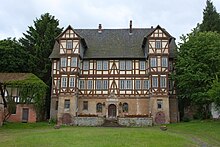Eschwege (noble family)
Eschwege is the name of an ancient Hessian nobility . The family is registered with the Althessian Knighthood , which is still in existence today , and had its headquarters on the Wasserburg Aue near the north Hessian city of Eschwege , today the district town of the Werra-Meißner district in northeastern Hesse. The place appears for the first time in a document as eskiniwach in 974. The name means "settlement near the ash trees by the slowly flowing water".
history
origin

The family is first mentioned in a document in 1141 with Heinrich von Eschwege. Heinrich was Chancellor of Count Siegfried von Boyneburg-Northeim . The continuously documented line of the family begins with the knight Johann de Eschwege, who is mentioned in documents from 1314 to 1370. The spelling of the gender name varies and was also written Aschinwege, Eschinwege and Eschwe.
Spread
Members of the family were early in the Werra area to Aue and Reichenbach wealthy. Later it was also possible to acquire properties in Thuringia , including for Kammerforst . In the county of Henneberg , Roßdorf was temporarily owned by the Lords of Eschwege.
Hans and Orban von Aschinwege appear in a document in 1425. In 1463 Johann and Härtung von Eschwege were enfeoffed by Landgrave Ludwig II with the goods that their brother-in-law Apel Appe had owned, including two thirds of the village and court of Ottersbach . Curt von Eschwege wore the Henneberg coat of arms during the exequies of the last Prince Count Georg Ernst von Henneberg in 1584 . From the beginning of the 16th century to the middle of the 18th century, the Lords of Eschwege were members of the imperial knighthood in the knightly canton of Rhön-Werra of the Franconian knight circle . In the middle of the 19th century, the main real estate was mainly in the Electorate of Hesse and, as a fiefdom , in the Kingdom of Hanover . Rudolph Friedrich Carl von Eschwege was a lieutenant in the Royal Hanoverian Garde du Corps in 1848 . The royal Saxon major Curt von Eschwege received an entry in the royal Saxon nobility book under number 392 on March 5, 1912 .
coat of arms
The coat of arms is split in red and silver. On the helmet with red and silver helmet covers, a tail wheel split by red and silver on a spike split by red and silver.
Known family members
- Carl von Eschwege (* 1798; † 1857), German chamberlain and politician
- Christian von Eschwege (* 1793; † July 1821), lieutenant and last death knight (black knight) for the House of Hesse at the funeral of Elector Wilhelm I of Hesse-Kassel
- Elmar von Eschwege (* 1856; † 1935), landscape, animal and war painter
- Ernst von Eschwege (* 1859; † 1932), head forest master
- Ernst Alexander von Eschwege (* 1948; † 2000), German actor and director
- Ferdinand von Eschwege (* 1790; † 1857), lieutenant general of the Electorate of Hesse, member of the assembly of the Electorate of Hesse
- Heinz von Eschwege (* 1890; † 1951), German journalist, creator of "Lolita"
- Karl von Eschwege (* 1826; † 1890), 1868–1890 District Administrator of the Fritzlar district
- Rudolf von Eschwege (* 1895 - † 1917), German fighter pilot
- Wilhelm Ludwig von Eschwege (* 1777; † 1855), German miner, geologist and geographer, Royal Portuguese Lieutenant Field Marshal
literature
- Marcelli Janecki : Handbook of the Prussian Nobility , second volume. Mittler and Son, Berlin, 1893, pp. 220–225. ( Digitized )
- Ernst Heinrich Kneschke : New general German nobility lexicon . Volume 3, Friedrich Voigt's Buchhandlung, Leipzig 1861, page 158. ( digitized version )
- Ernst Heinrich Kneschke : The coats of arms of the German baronial and noble families. Volume 1, TO Weigel, Leipzig 1855; Pages 143-144; ( Digitized version )
- Genealogisches Handbuch des Adels , Adelslexikon Volume III, Volume 61 of the complete series, page 180; CA Starke Verlag, Limburg (Lahn) 1975, ISSN 0435-2408
- Gothaisches Genealogisches Taschenbuch der Areligen Häuser , Part A, 33 year, Gotha 1934, page 177
Web links
- Eschwegen or Eschenwegen, an aristocratic family. In: Johann Heinrich Zedler : Large complete universal lexicon of all sciences and arts . Volume 8, Leipzig 1734, column 1869.
- Coat of arms of the von Eschwege family in Johann Siebmacher's coat of arms book (1605)
- The von Eschwege family in Gen-Wiki
Individual evidence
- ↑ www.eschwege.de
- ^ Christian Ludwig Scheidt : Origines Guelficae. Volume IV, page 523 or Otto Dobecker : Regesta diplomatica necnon epistolaria historiae Thuringiae. I. No. 1432
- ↑ a b c Genealogisches Handbuch des Adels , Adelslexikon Volume III, Volume 61 of the complete series, page 180
- ↑ a b c New General German Adels Lexicon Volume 3, Pages 158–161
- ^ Gerhard Köbler : Historical Lexicon of the German Lands. The German territories from the Middle Ages to the present. 7th, completely revised edition. CH Beck, Munich 2007, ISBN 978-3-406-54986-1 , p. 174.


